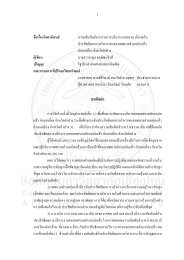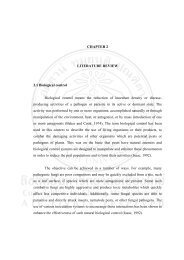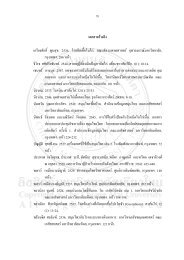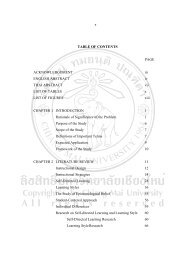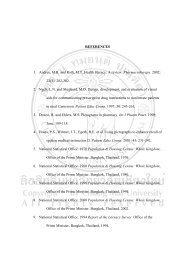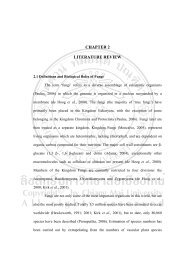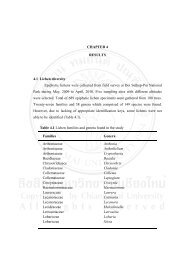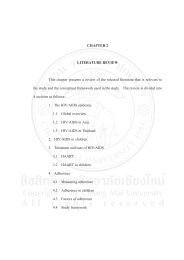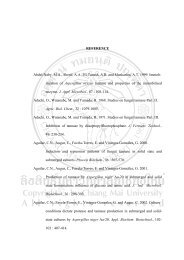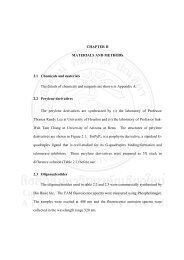prevalence and molecular characteristics of vibrio species in pre ...
prevalence and molecular characteristics of vibrio species in pre ...
prevalence and molecular characteristics of vibrio species in pre ...
You also want an ePaper? Increase the reach of your titles
YUMPU automatically turns print PDFs into web optimized ePapers that Google loves.
21<br />
2.7.4 Genotypic <strong>characteristics</strong> <strong>of</strong> Vibrio<br />
Researchers have <strong>in</strong>vestigated the phenotypic <strong>and</strong> genotypic characterization<br />
<strong>of</strong> the Vibrio organism us<strong>in</strong>g new <strong>molecular</strong> technology based on the ribotyp<strong>in</strong>g <strong>and</strong><br />
polymerase cha<strong>in</strong> reaction technique such as amplified fragmented length<br />
polymorphism (AFLP), fluorescence <strong>in</strong> situ hybridization (FISH) or multi locus<br />
sequence typ<strong>in</strong>g (MLST) (Thompson et al., 2004). Identification <strong>of</strong> toxigenic genes<br />
<strong>and</strong> serogroups (Dalsgaard et al., 2001, Janssen et al., 1996, Raghunath et al., 2008),<br />
genetic diversity (Jiang et al., 2000, Sawabe et al., 2002, Zo et al., 2002), ecological<br />
<strong>in</strong>teraction <strong>and</strong> relatedness <strong>of</strong> cl<strong>in</strong>ical <strong>and</strong> environmental isolates (Zo et al., 2002) <strong>of</strong><br />
Vibrio has been carried out with the help <strong>of</strong> new techniques. Toxigenic Vibrio<br />
cholerae O1 samples from the aquatic environment <strong>and</strong> human <strong>in</strong>test<strong>in</strong>es isolated<br />
from Bangladesh were analyzed by enterobacterial repetitive <strong>in</strong>tergenic consensus<br />
sequence-PCR, optimized for pr<strong>of</strong>il<strong>in</strong>g by us<strong>in</strong>g the fully sequenced V. cholerae E1<br />
Tor N16961 genome. A study found a similar composition <strong>of</strong> environmental toxigenic<br />
V. cholerae <strong>and</strong> the V. cholerae that causes the endemic cholera. Authors conclude<br />
that the spatial <strong>and</strong> temporal fluctuation (seasonal fluctuations <strong>in</strong> the environment,<br />
<strong>in</strong>troduction <strong>of</strong> new stra<strong>in</strong>) <strong>in</strong> the composition <strong>of</strong> the toxigenic V. cholerae population<br />
<strong>in</strong> the aquatic environment can cause shifts <strong>in</strong> the dynamics <strong>of</strong> this disease (Zo et al.,<br />
2002). An <strong>in</strong>vestigation carried out by Jiang et al. (2000) detected V. cholerae isolates<br />
<strong>in</strong> Chesapeake Bay coastal waters. The genetic diversity analyzed by apply<strong>in</strong>g AFLP<br />
f<strong>in</strong>gerpr<strong>in</strong>t<strong>in</strong>g revealed the l<strong>in</strong>k between the shift <strong>of</strong> the genotype <strong>and</strong> environmental<br />
changes such as water temperature.<br />
MLST was developed recently <strong>and</strong> considered as most reliable <strong>molecular</strong> tool<br />
for the epidemiology. This method is based on the sequence analysis <strong>of</strong> housekeep<strong>in</strong>g<br />
(HK) genes <strong>of</strong> the organism. Higher discrim<strong>in</strong>atory power, accuracy <strong>and</strong> portability <strong>of</strong><br />
the data, ease <strong>of</strong> performance, <strong>and</strong> reproducibility are major advantages <strong>of</strong> this<br />
method (Thompson et al., 2004). Nucleic acid sequences are stored <strong>in</strong> a public data<br />
base that can be easily accessed via <strong>in</strong>ternet (http://www.mlst.net or<br />
http://pubmlst.org) (González-Escalona et al., 2008). Scientist applied this method to<br />
determ<strong>in</strong>e the global epidemiology <strong>of</strong> bacterial pathogens. González-Escalona et al.




